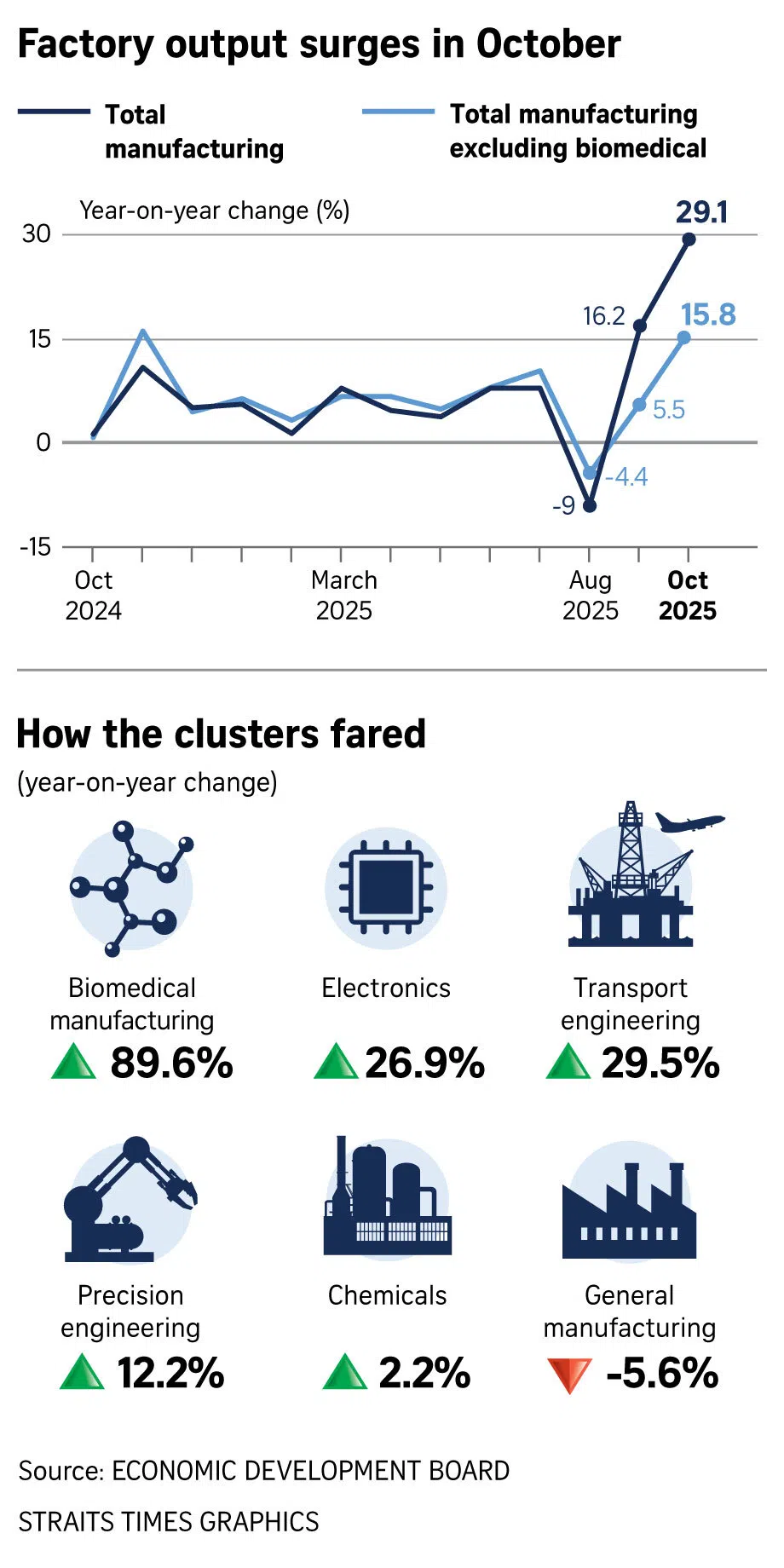Singapore factory output surprises with 29.1% surge in October, led by pharma and electronics
Sign up now: Get ST's newsletters delivered to your inbox

The delay in the implementation of pharma tariffs and relentless AI demand is driving output, said analysts.
PHOTO: ST FILE
Follow topic:
SINGAPORE - Singapore’s factory output accelerated in October, swelling more than expected, led by strong electronics and pharmaceutical production.
Analysts said the manufacturing sector has demonstrated continued resilience to defy the shocks from US tariffs and geopolitical uncertainties. The delay in the implementation of US pharma tariffs and relentless artificial intelligence (AI) demand drove output in October, they added.
Manufacturing output jumped 29.1 per cent year on year, far exceeding the 6.7 per cent rise forecast by analysts in a Bloomberg poll and the revised 16.2 per cent growth in September.
Excluding the biomedical industry, production in October rose 15.8 per cent, according to data released by the Economic Development Board (EDB) on Nov 26.
On a seasonally adjusted month-on-month basis, manufacturing output increased by 11.5 per cent. Excluding biomedical manufacturing, it rose 11.7 per cent.
The sector, typically known to be volatile, saw output swelling 89.6 per cent year on year, after a 45.6 per cent rise in September.
Pharmaceuticals soared 122.9 per cent because of higher production of active pharmaceutical ingredients and biological products. The medical technology segment grew 7.3 per cent on the back of sustained export demand for medical devices.
Mr Chua Han Teng, senior economist at DBS, said the increase in pharmaceuticals output could also be attributed to a delay in the implementation of US tariffs on pharmaceutical products. This afforded Singapore-based pharmaceutical companies enough time to negotiate exemptions with the US.
US President Donald Trump announced on Sept 25 a 100 per cent tariff on branded or patented pharmaceutical imports from Oct 1, unless the company is building a manufacturing facility in the country. This was delayed on Oct 14.
Pharmaceutical production was likely still running at an accelerated pace to fulfil front-loaded orders, said UOB economist Jester Koh.
Output from the key electronics industry – which accounts for more than a third of all factory production – rose 26.9 per cent.
Semiconductors, which make up over 80 per cent of electronics production here, saw a 17 per cent rise in output, while the infocomms and consumer electronics segment surged 155.6 per cent.
The computer peripherals and data storage segment grew 0.5 per cent, while the other electronic modules and components segment dropped 5.7 per cent.
Mr Chua noted that the electronics cluster could hold up for some time in the near term, supporting the overall manufacturing sector because of relentless AI-related demand and US tariff exemptions on electronics goods.
Maybank’s regional co-head of macro research Chua Hak Bin added that America’s six largest tech giants – Alphabet, Amazon, Apple, Meta, Microsoft and Oracle – could increase capital expenditure by around 34 per cent, opening up more opportunities and growth for Singapore’s tech supply chain.
However, the local manufacturing sector could also face challenges, said DBS’ Mr Chua.
“Singapore’s electronics upcycle is beginning to look mature and would have to contend with lingering threats of US semiconductor tariffs, with the ultimate downside impact dependent on the eventual conditions, as well as downside risks from any disorderly pullback in exuberant sentiment over the AI boom.”
Another industry that enjoyed strong output growth was transport engineering, up 29.5 per cent year on year.

Its aerospace segment expanded 50.6 per cent, bolstered by higher production of aircraft parts and more higher-value maintenance, repair and overhaul jobs from commercial airlines.
The marine and offshore engineering segment grew 7 per cent, driven by increased activities in ship repairing and construction of oil rigs and platforms. Conversely, the land segment declined 23.9 per cent.
Output from the precision engineering sector grew 12.2 per cent. The machinery and systems segment increased 13.9 per cent with higher production in semiconductor equipment and process control equipment industries.
Meanwhile, the precision modules and components segment rose 5.7 per cent, supported by higher output of electronic connectors, as well as electric power cables and wires.
The chemicals industry saw the least growth among all the sectors that expanded in October.
Its output rose 2.2 per cent, with the specialties segment growing 42.8 per cent from a low base in 2024 due to plant maintenance shutdowns. However, the other chemicals and petroleum segments declined 0.2 per cent and 2.5 per cent, respectively, while the petrochemicals segment contracted 17.8 per cent because of plant maintenance shutdowns.
The general manufacturing industry continued to contract in October, with output falling 5.6 per cent on the back of declines in all segments. The miscellaneous industries and printing segments dipped 2.3 per cent and 3.2 per cent, respectively. The food, beverages and tobacco segment saw lower production of milk powder, cocoa and bakery products, with production falling 8.2 per cent.
Based on October’s robust performance, manufacturing growth in the fourth quarter is likely to exceed the already strong 5 per cent in the third quarter, said Maybank’s Dr Chua.


